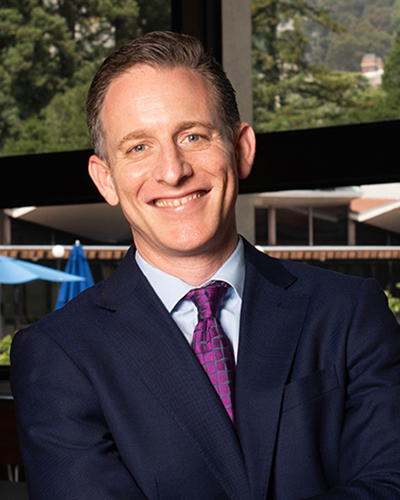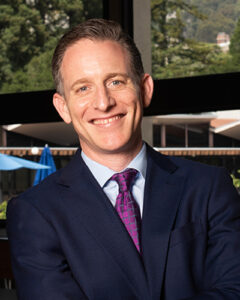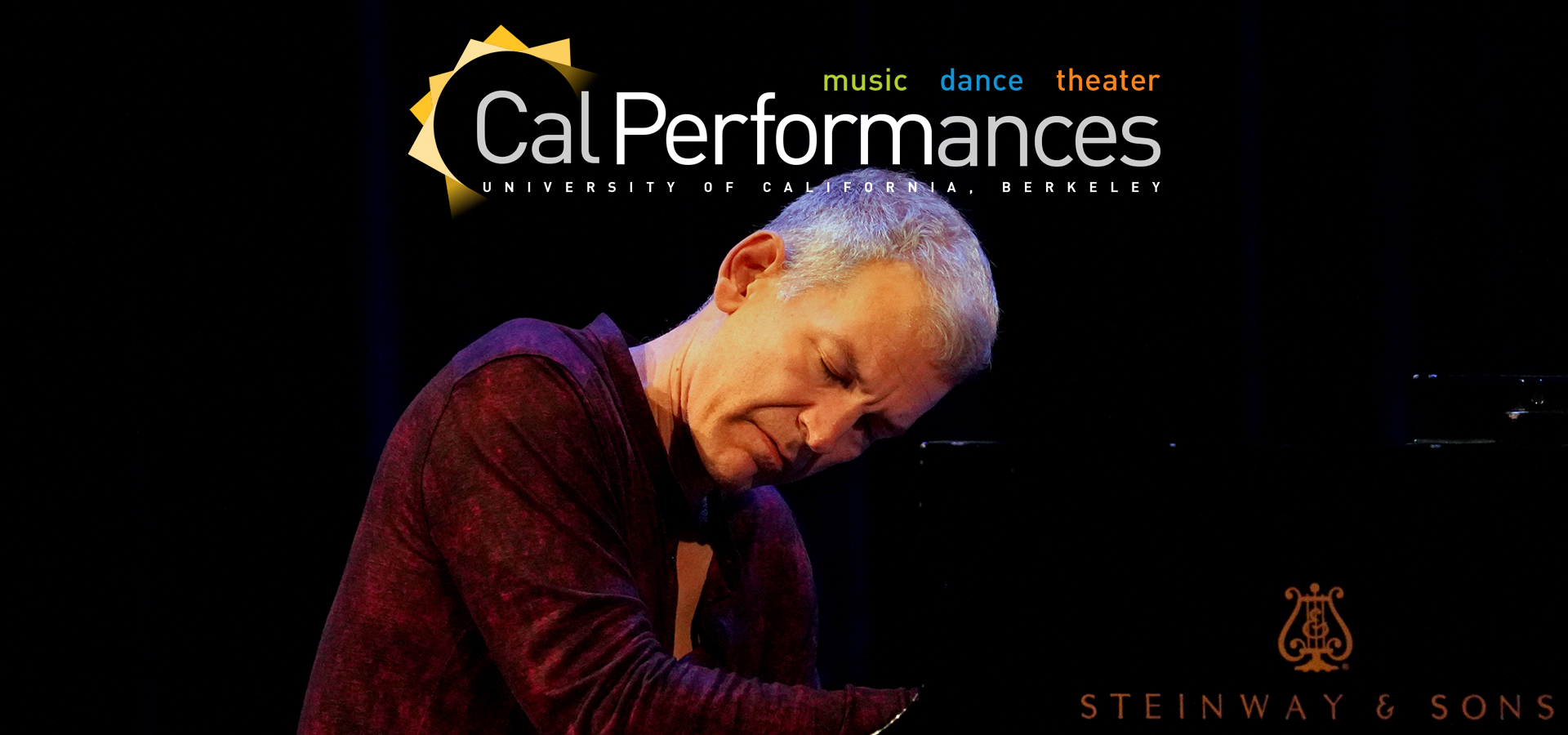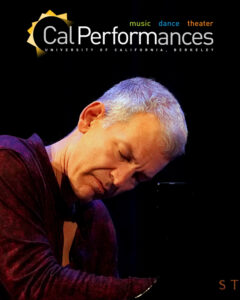Brad Mehldau
Saturday, February 10, 2024, 8pm
Zellerbach Hall
This performance is made possible, in part, by Nadine Tang.
Cal Performances is committed to fostering a welcoming, inclusive, and safe environment for all—one that honors our venues as places of respite, openness, and respect.
Please see the Community Agreements section on our Policies webpage for more information.
From the Executive and Artistic Director

I’m so pleased to welcome you back to campus as we move into the second half of our extraordinary 2023–24 season. There are far too many highlights this month for me to mention each and every one, but I can’t help but single out a few standout events. Of course, any visit by the legendary soprano Renée Fleming is worthy of attention, and this month’s Zellerbach Hall appearance is no exception, coming, as it does, hot on the heels of her receiving the prestigious Kennedy Center Honor for lifetime artistic achievement in December. For dance, you won’t want to miss a dazzling double-bill pairing the late Pina Bausch’s iconic The Rite of Spring with common ground[s], a new duet co-created and performed by septuagenarians Germaine Acogny, known as the “mother of African contemporary dance,” and Malou Airaudo, a longtime dancer with the Tanztheater Wuppertal Pina Bausch. Featuring more than 30 dancers from 14 African countries assembled through a collaboration with Germany’s Pina Bausch Foundation, Senegal’s École des Sables, and the UK’s Sadler’s Wells theater, this program is the type of large-scale and ambitious artistic collaboration that has long defined Cal Performances. And finally, we’re tremendously excited about Taylor Mac & Matt Ray’s upcoming Bark of Millions (see page 6 for more details), an epic “parade trance extravaganza” that celebrates queerness in all its facets and the power of individuality and human connection to push boundaries and bring bold and fresh perspectives to our stage.
As spring approaches, we will continue to invest in ongoing relationships with established and acclaimed artistic partners, with upcoming projects including the renewal of a multi-season residency by The Joffrey Ballet, which this year will present its first full-length narrative ballet, Anna Karenina, at Zellerbach Hall. And I’m especially pleased that in March, the renowned pianist Mitsuko Uchida will join us as Artist in Residence for two special concerts as well as additional opportunities for the campus and wider Bay Area community to engage with her singular artistry.
An ongoing focus of the season is our multi-dimensional Illuminations programming, which once again connects the work of world-class artists to the intellectual life and scholarship at UC Berkeley via performances and public programs investigating a pressing theme—this season, “Individual & Community.” Concepts of “individual” and “community” have been at the forefront of public discourse in recent years, with new questions emerging as to how we can best nurture a sense of community and how the groups we associate with impact our own sense of self. Given our fast-evolving social landscape, how can we retain and celebrate the traits that make each of us unique, while still thriving in a world that demands cooperation and collaboration? With the performing arts serving as our guide and compass, we will explore the tensions that come into play when balancing the interests of the individual with those of the group.
Finally, I want to mention a major new venture coming up next season, the Maria Manetti Shrem and Elizabeth Segerstrom California Orchestra Residency, when Cal Performances and the Philharmonic Society of Orange County will bring the world renowned Vienna Philharmonic and conductor Yannick Nézet-Séguin to California during spring 2025. Made possible by philanthropists Maria Manetti Shrem and Elizabeth Segerstrom, three performances at Zellerbach Hall (March 5–7) will be followed by two in Orange County (March 9 and 11) at the Renée and Henry Segerstrom Concert Hall. Programs will feature works by Mozart, Schubert, Dvořák, Mahler, and Richard Strauss, with acclaimed pianist Yefim Bronfman set to join the orchestra for a Beethoven concerto appearance. Exact programming will be announced shortly, and on-sale dates will be provided in April, when Cal Performances’ 2024–25 season is announced to the general public.
Again, welcome to Cal Performances! We’re delighted to join together, celebrating the very best in live music, dance, and theater.
Jeremy Geffen
Executive and Artistic Director, Cal Performances
 I’m so pleased to welcome you back to campus as we move into the second half of our extraordinary 2023–24 season. There are far too many highlights this month for me to mention each and every one, but I can’t help but single out a few standout events. Of course, any visit by the legendary soprano Renée Fleming is worthy of attention, and this month’s Zellerbach Hall appearance is no exception, coming, as it does, hot on the heels of her receiving the prestigious Kennedy Center Honor for lifetime artistic achievement in December. For dance, you won’t want to miss a dazzling double-bill pairing the late Pina Bausch’s iconic The Rite of Spring with common ground[s], a new duet co-created and performed by septuagenarians Germaine Acogny, known as the “mother of African contemporary dance,” and Malou Airaudo, a longtime dancer with the Tanztheater Wuppertal Pina Bausch. Featuring more than 30 dancers from 14 African countries assembled through a collaboration with Germany’s Pina Bausch Foundation, Senegal’s École des Sables, and the UK’s Sadler’s Wells theater, this program is the type of large-scale and ambitious artistic collaboration that has long defined Cal Performances. And finally, we’re tremendously excited about Taylor Mac & Matt Ray’s upcoming Bark of Millions (see page 6 for more details), an epic “parade trance extravaganza” that celebrates queerness in all its facets and the power of individuality and human connection to push boundaries and bring bold and fresh perspectives to our stage.
I’m so pleased to welcome you back to campus as we move into the second half of our extraordinary 2023–24 season. There are far too many highlights this month for me to mention each and every one, but I can’t help but single out a few standout events. Of course, any visit by the legendary soprano Renée Fleming is worthy of attention, and this month’s Zellerbach Hall appearance is no exception, coming, as it does, hot on the heels of her receiving the prestigious Kennedy Center Honor for lifetime artistic achievement in December. For dance, you won’t want to miss a dazzling double-bill pairing the late Pina Bausch’s iconic The Rite of Spring with common ground[s], a new duet co-created and performed by septuagenarians Germaine Acogny, known as the “mother of African contemporary dance,” and Malou Airaudo, a longtime dancer with the Tanztheater Wuppertal Pina Bausch. Featuring more than 30 dancers from 14 African countries assembled through a collaboration with Germany’s Pina Bausch Foundation, Senegal’s École des Sables, and the UK’s Sadler’s Wells theater, this program is the type of large-scale and ambitious artistic collaboration that has long defined Cal Performances. And finally, we’re tremendously excited about Taylor Mac & Matt Ray’s upcoming Bark of Millions (see page 6 for more details), an epic “parade trance extravaganza” that celebrates queerness in all its facets and the power of individuality and human connection to push boundaries and bring bold and fresh perspectives to our stage.
As spring approaches, we will continue to invest in ongoing relationships with established and acclaimed artistic partners, with upcoming projects including the renewal of a multi-season residency by The Joffrey Ballet, which this year will present its first full-length narrative ballet, Anna Karenina, at Zellerbach Hall. And I’m especially pleased that in March, the renowned pianist Mitsuko Uchida will join us as Artist in Residence for two special concerts as well as additional opportunities for the campus and wider Bay Area community to engage with her singular artistry.
An ongoing focus of the season is our multi-dimensional Illuminations programming, which once again connects the work of world-class artists to the intellectual life and scholarship at UC Berkeley via performances and public programs investigating a pressing theme—this season, “Individual & Community.” Concepts of “individual” and “community” have been at the forefront of public discourse in recent years, with new questions emerging as to how we can best nurture a sense of community and how the groups we associate with impact our own sense of self. Given our fast-evolving social landscape, how can we retain and celebrate the traits that make each of us unique, while still thriving in a world that demands cooperation and collaboration? With the performing arts serving as our guide and compass, we will explore the tensions that come into play when balancing the interests of the individual with those of the group.
Finally, I want to mention a major new venture coming up next season, the Maria Manetti Shrem and Elizabeth Segerstrom California Orchestra Residency, when Cal Performances and the Philharmonic Society of Orange County will bring the world renowned Vienna Philharmonic and conductor Yannick Nézet-Séguin to California during spring 2025. Made possible by philanthropists Maria Manetti Shrem and Elizabeth Segerstrom, three performances at Zellerbach Hall (March 5–7) will be followed by two in Orange County (March 9 and 11) at the Renée and Henry Segerstrom Concert Hall. Programs will feature works by Mozart, Schubert, Dvořák, Mahler, and Richard Strauss, with acclaimed pianist Yefim Bronfman set to join the orchestra for a Beethoven concerto appearance. Exact programming will be announced shortly, and on-sale dates will be provided in April, when Cal Performances’ 2024–25 season is announced to the general public.
Again, welcome to Cal Performances! We’re delighted to join together, celebrating the very best in live music, dance, and theater.
Jeremy Geffen
Executive and Artistic Director, Cal Performances
A Message from the Artist
Fourteen Reveries came from a similar impulse as the suite from three years ago, April 2020, to write shorter pieces. In both sets, I’ve eschewed larger-scale development, opting for brevity. Each piece is more like a distillation of emotion. If there is one link of mood here in this set, it is that of reverie. The music might accompany those moments during waking hours, when we withdraw from our exterior environment. Reverie can be welcome, perhaps as a diversion from the banality of one’s surroundings. At other times, it is an involuntary flight into melancholy. In all cases, it is an interior experience, exclusive to our own consciousness, independent from others. The music here accordingly expresses solitude—at turns enraptured, placid, nervous, lonely or ecstatic.
Reverie is not so much an emotional state itself, but the interior frame in which those emotions knock around. There is often an element of quiet in these pieces—not necessarily in dynamic volume, but the quietude of passivity, as one allows those feelings to wash over them, without broadcasting them to anyone else. Outward quietude masks a flow of inner action. The music is less a willful display, and more like peeling back a curtain to reveal something.
Each piece is self-contained, and while there are no overt melodic themes or motifs that bind them together, they flow into each other, often attacca, with no pause, often connecting through their shared tonal center. The first five, thus, make up a group in C major; 7–9 move between G major and G minor. Metric connections appear as well, as in #2 and #9, which share the same placid 5/8 meter.
There are several pianistic obsessions I’ve wrestled with as a player and composer through the years, which play out in some of the pieces. One is to place a melody within its accompanying figuration, so that even as it takes center stage, it remains part of an undulating texture. One can hear that feature in the first, second and ninth pieces. Another compositional approach in the seventh piece was to avoid indicating the shifting time signatures in the written music, visually emphasizing for the player the fluid, gridless kind of state of the music. In the final more extended piece—as in “waiting,” the ninth piece from April 2020—the music has a clear pulse but no barlines at all, like a paragraph made up of one long sentence.
The more I’ve studied the masters over the years, the more I have been fascinated by what the composer “tells” the pianist in the score—or doesn’t tell—sometimes overtly, sometimes obliquely; concerning dynamics, articulation, tempi, pedalling, and emotional direction. There is usually some balance of specificity and open-endedness. A composer like Brahms in his Klavierstücke gives the player everything they need to let the beauty and sublimity of the music reveal itself, but also leaves things to be discovered: there are all sorts of counter-melodies hiding between the hands that are not marked with accents. This is part of the reason for the longevity of that music—in its multi-dimensionality, it gives the player choices, and invites them to interpret it differently from one performance to another.
In some of the pieces here, I’ve exploited those kinds of hidden currents and made them more explicit, marking them with accents and tenutos. At other times, I’ve followed my master Brahms, and written only the notes. For the final (14th) piece, there is the following direction on the top of the page:
Dynamics have not been given; the player is free to choose, and is encouraged to find melodies within the figuration and bring them out as they wish, through louder dynamic, marcato touch, and perhaps finger-pedalling. Time signature and barlines not given; each system traces a possible phrase length, sometimes obvious, but they are only guidelines, allowing the player to feel the piece as a continuous stream.
The strongest model for open-endedness in many respects is Bach, who left us with little to no indications for tempo, articulation, and dynamics. In the last piece here, the listener can hear the inspiration I’ve drawn from many of his preludes in the Well-Tempered Clavier. Like one long wave from beginning to end, it nevertheless invites the performer to draw out a more segmented story with their own sentences, paragraphs, and chapter, if they wish. In this regard, finally, the music I’ve written is not only inspired by composers, but by the great interpreters who have shaped their music.
—Brad Mehldau



